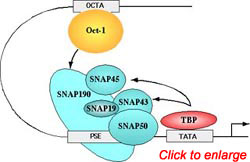Current Research
We study transcription of human small nuclear (sn) RNA genes as a model system to understand mechanisms of transcription and regulation of gene expression. Correctly regulated gene expression is important for healthy development and the maintenance of cellular homeostasis. Disruptions in transcriptional regulation are observed in many disease states including cancer. Moreover, viruses subvert the cellular transcriptional programs for their own benefit during viral infection.
Therefore, it is important to understand the transcriptional mechanisms that underlie control of gene expression. Human snRNA genes encode short stable RNAs that as part of specialized protein-snRNA complexes typically are involved in processing other RNA molecules.
For example, snRNAs are essential for mRNA splicing, rRNA processing, and tRNA processing.
In addition, other snRNAs process RNA primers required for mitochondrial DNA replication. Thus, snRNAs play pivotal roles in numerous cellular processes. The genes for these snRNAs are unusual because they have similar promoter architectures and yet some snRNA genes are transcribed by RNA polymerase II while others are transcribed by RNA polymerase III. These differences in polymerase choice make this an interesting system for understanding mechanisms of transcription for both RNA polymerases II and III.
The PSE is recognized by the basal transcription factor referred to as snRNA-activating protein complex (SNAPc). SNAPc is a multi-protein complexcomposed of at least five proteins SNAP19, SNAP43, SNAP45, SNAP50,and SNAP190. In addition, the TATA-box binding protein (TBP) can also associate with this complex. Each of these proteins is required for transcription of human snRNA genes by both RNA polymerase II and III.
Our research is focused on how SNAPc functions for snRNA gene transcription. We are
interested in four fundamental issues: (1) How does SNAPc function in transcription
by both RNA polymerase II and III?
(2) How does SNAPc communicate with other specialized factors that are dedicated for
transcription by only RNA polymerase II or III?
(3) Is SNAPc the target of transcription regulatory proteins?
(4) Does SNAPc selectively mediate transcription of some snRNA genes depending upon
the demands of the cell?
Answers to these questions are important for understanding the complicated network of transcription regulation in the cell.
